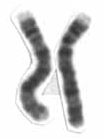Haemophilia C
| Haemophilia C | |
|---|---|
| Other names | Plasma thromboplastin antecedent (PTA) deficiency, Rosenthal syndrome |
Haematology | |
| Symptoms | Oral bleeding[2] |
| Causes | Deficiency of coagulation factor XI[1] |
| Diagnostic method | Prothrombin time[1] |
| Prevention | Physical activity precautions[1] |
| Treatment | tranexamic acid[3] |
Haemophilia C (also known as plasma thromboplastin antecedent (PTA) deficiency or Rosenthal syndrome) is a mild form of
Signs and symptoms
In terms of the signs/symptoms of haemophilia C, unlike individuals with
- Oral bleeding.
- Nosebleeds
- Blood in the urine
- Post-partumbleeding (20% of cases)
- Tonsils(bleeding)
Cause

Haemophilia C is caused by a deficiency of
Many mutations exist, and the bleeding risk is not always influenced by the severity of the deficiency. Haemophilia C is occasionally observed in individuals with
Diagnosis
The diagnosis of haemophilia C (factor XI deficiency) is centered on prolonged activated partial thromboplastin time (aPTT). One will find that the factor XI has decreased in the individual's body. In terms of differential diagnosis, one must consider: haemophilia A, haemophilia B, lupus anticoagulant and heparin contamination.[4][10] The prolongation of the activated partial thromboplastin time should completely correct with a 1:1 mixing study with normal plasma if haemophilia C is present; in contrast, if a lupus anticoagulant is present as the cause of a prolonged aPTT, the aPTT will not correct with a 1:1 mixing study.[citation needed]
Treatment
In terms of haemophilia C medication tranexamic acid is often used for both treatment after an incident of bleeding and as a preventive measure to avoid excessive bleeding during oral surgery.[3]
Treatment is usually not necessary, except in relation to operations, leading to many of those having the condition not being aware of it. In these cases, fresh frozen plasma or recombinant factor XI may be used, but only if necessary.[4][11]
Those affected may often develop nosebleeds, while females can experience unusual menstrual bleeding which can be avoided by taking birth control such as:
-
Cyklokapron (Tranexamic acid)
-
Fresh Frozen Plasma
See also
References
- ^ a b c d e f g "Hemophilia C: Background, Etiology, Epidemiology". December 9, 2021 – via eMedicine.
{{cite journal}}: Cite journal requires|journal=(help) - ^ S2CID 37670882.
- ^ PMID 24264665.
- ^ a b c "Factor XI Deficiency: Background, Pathophysiology, Epidemiology". 2018-07-02.
{{cite journal}}: Cite journal requires|journal=(help) - ^ "Factor XI deficiency | Disease | Overview | Genetic and Rare Diseases Information Center (GARD) – an NCATS Program". rarediseases.info.nih.gov. Archived from the original on 2019-12-16. Retrieved 2016-07-09.
- S2CID 27557689.
- ISBN 978-0-470-67050-7.
- ^ "OMIM Entry - # 612416 - FACTOR XI DEFICIENCY". omim.org. Retrieved 2016-07-12.
- ISBN 978-1455733293.
- ^ RESERVED, INSERM US14 -- ALL RIGHTS. "Orphanet: Congenital factor XI deficiency Hemophilia C". www.orpha.net. Retrieved 2016-07-12.
{{cite web}}: CS1 maint: numeric names: authors list (link) - ISBN 9780323291774.
Further reading
- Zucker, M.; Zivelin, A.; Landau, M.; Salomon, O.; Kenet, G.; Bauduer, F.; Samama, M.; Conard, J.; Denninger, M.-H.; Hani, A.-S.; Berruyer, M.; Feinstein, D.; Seligsohn, U. (1 October 2007). "Characterization of seven novel mutations causing factor XI deficiency". Haematologica. 92 (10): 1375–1380. PMID 18024374.
- Orkin, Stuart H.; Nathan, David G. (2008). Nathan and Oski's Hematology of Infancy and Childhood. Elsevier Health Sciences. ISBN 978-1416034308. Retrieved 12 July 2016.
- Goldman, Lee; Schafer, Andrew I. (2016). Goldman-Cecil Medicine Elsevieron VitalSource. Elsevier Health Sciences. ISBN 9780323322850. Retrieved 12 July 2016.


